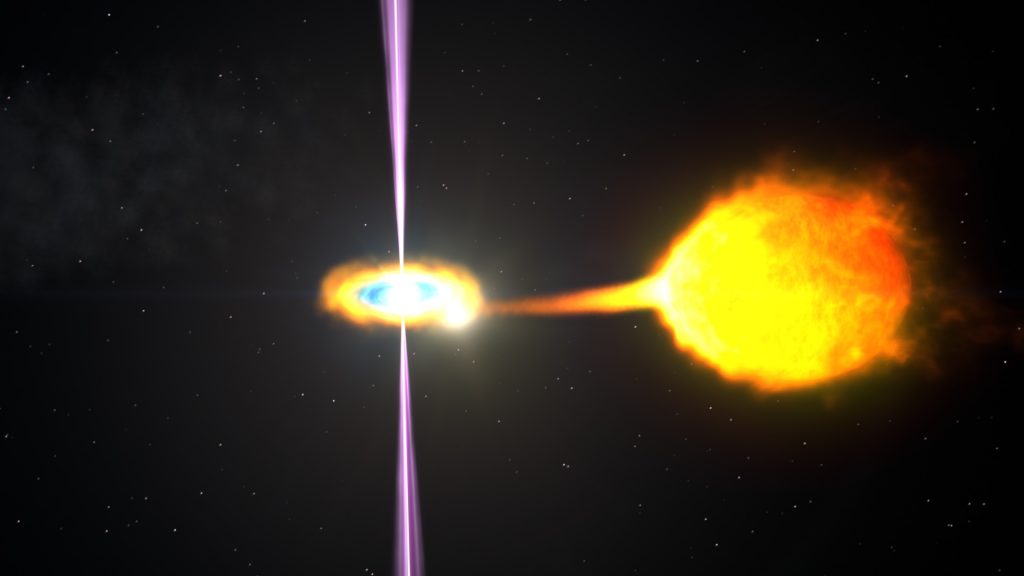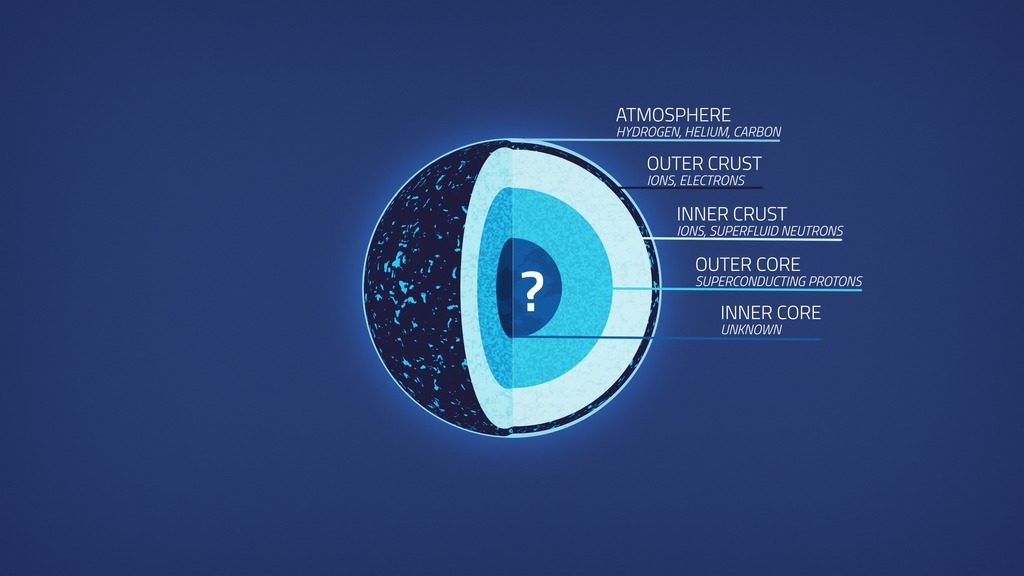#PulsarWeek: NICER Ask Me Anything! – Part 1
- By Sara Mitchell
- August 16, 2017
- Comments Off on #PulsarWeek: NICER Ask Me Anything! – Part 1
On August 7, 2017, as the grande finale to #PulsarWeek, members of the recently-launched Neutron star Interior Composition Explorer (NICER) mission team sat down for an hour to answer questions about the mission, pulsars, space navigation, and even more off-the-wall topics in a Reddit Ask Me Anything (AMA) event. We’ve gathered the questions and answers here and in our next post so they’re easier to read – you can check out the original AMA here.
As we’ve talked about before here on Blueshift, pulsars are rotating “lighthouse” neutron stars that began their lives as stars between about seven and 20 times the mass of our sun. For the first time, NASA has a mission to study pulsars using X-ray technology to uncover mysteries of the cosmos while paving the way for future space exploration. This two-in-one mission is called NICER-SEXTANT and it’s currently aboard the International Space Station.
For more background, here is a recent feature about NICER and its study of pulsars, and a Tumblr about five famous pulsars from the past 50 years.

The NICER AMA team gathered to answer questions on Reddit (not pictured: additional members on the phone).
Answering questions for the AMA were a number of members of the NICER-SEXTANT team and Goddard’s Communications team:
- Dr. Keith Gendreau – NICER Principal Investigator, NASA’s Goddard Space Flight Center
- Dr. Zaven Arzoumanian – NICER Science Lead, NASA’s Goddard Space Flight Center
- Dr. Craig Markwardt – NICER Calibration Lead & Neutron Star Scientist, NASA’s Goddard Space Flight Center
- Dr. Luke Winternitz – SEXTANT Systems Architect, NASA’s Goddard Space Flight Center
- Dr. Jason Mitchell – SEXTANT Project Manager, NASA’s Goddard Space Flight Center
- Dr. Rita Sambruna – NICER Program Scientist, NASA Headquarters
- Dr. Slavko Bogdanov – Pulsar/Neutron star Scientist, Columbia University
- Aries Keck – NASA’s Goddard Space Flight Center
Here we have answers to questions about pulsars themselves – pulsar basics, pulsar rotation, pulsar magnetic fields, pulsars and gravitational radiation, and extreme physics around pulsars.
Check out our next post for the questions and answers about the NICER mission and SEXTANT technology demonstration, pulsar detection, studying pulsars and pulsars and galactic navigation.
Pulsar Basics
Q: What would happen if two or more pulsars collided? (Brock1313)
Craig: This is a really good question. In most circumstances, there are not enough pulsars to literally collide head-on. However, if two pulsars are orbiting each other in a binary pulsar system then they will slowly inspiral due to emission of gravitational waves. Eventually (billions of years) the pulsars will coalesce. It is thought that inspiral-based neutron star coalescence is one source of gamma-ray bursts (GRBs), which are the most powerful explosions in the universe. The explosion will be an immense conversion of nuclear-density matter (i.e. a giant gamma-ray explosion) and conversion into a into a black hole.
A supercomputer simulation of a pair of neutron stars colliding, merging and forming a black hole. Credit: NASA’s Goddard Space Flight Center
Q: What powers the pulsars? Stars are powered by fusion, but pulsars should be made mostly out of neutrons. Is it the leftover energy from the supernova that created them? (Quacken8)
Craig: Great question. For the most part, pulsars only have the energy left over from the supernova that created them. They are hot, so they can radiate thermal X-ray emission, and they are often rotating quickly, so they can somehow radiate their rotational energy. (in this case, it would be somewhat like a dipole radiator). Once this energy is exhausted, it is believed that pulsars will turn off and become a cold and dark neutron star. There are strong suspicions that our galaxy is a “graveyard” of old neutron stars floating around.
That being said, there are exceptions. If a neutron star is orbiting a binary companion, that companion can donate matter (gas), which will come crashing down on the star. The star can glow so hot from this interaction, that it will glow in X-rays (millions of degrees). Also, eventually enough hydrogen gas can collect on the surface of a neutron star that a short flash of fusion can occur (about 10 seconds), which converts the hydrogen to helium. This can go on for the life of the binary system.
Q: Can a pulsar collapse all by itself into a black hole spontaneously just by eating? That is, not considering a merging of two pulsars. (schmick)
Craig: Yes, this is known as accretion-based collapse of a neutron star into a black hole. Neutron stars are supported by the quantum pressure of degenerate neutrons. That is a mouthful! Degeneracy pressure is a powerful thing, but it is not limitless. If you pile enough matter onto a neutron star, the matter can overcome the degeneracy pressure and cause the star to collapse into a black hole. The source of this matter is almost always a companion star. In other words, two stars that formed together as a binary pair, and one went supernova to a neutron star, and the other stuck around to donate mass.

This artist’s rendering shows a model of pulsar J1023, showing a stream of gas from its companion. Credit: NASA’s Goddard Space Flight Center
Q: Can you compare a pulsar to a black hole in term of mass and size? Which one appear to be more common? Which are the bigger/smaller on average? Does a pulsar emit light? From the ray only or all of it’s surface? Does planet still orbit around a pulsar? How does a pulsar is formed? (Like black hole? Massive red star into pulsar or BH?) (Zykino)
Craig: Black hole vs. neutron star mass. Generally speaking in an astronomical context, a neutron star is between about 1 and 2 solar masses, whereas a black hole can be larger. In a cosmological context, it is possible there could be microscopic black holes, but these are formed in the early universe, not by stellar processes.
More common? This is an open question. There are probably many more neutron stars in our galaxy because the stellar evolution processes that produce them are more common. However, many neutron stars in our galaxy could be hidden if they are cold and/or are not near a source of matter that could “light up.”
Does a pulsar emit light? Optical light is possible. The Crab pulsar is well known to be an optical pulsar. Many pulsars are radio, X-ray or gamma-ray emitters.
Does a planet still orbit around a pulsar? Yes, there have been claims about planets around pulsars. These are discovered because the planet disturbs the motion of the pulsar, and this can be detected by detailed timing measurements.
How is a pulsar formed? It’s too difficult to answer here in short form. Most pulsars are formed when a massive star evolves to supernova; the outer layers of the star is ejected in the supernova explosion, and the hot nuclear core of the star remains. If it is rapidly spinning, it will likely be a pulsar.
Q: What conditions are necessary for a pulsar to form? When in the process of stellar evolution would pulsars be? (ColdS3)
Craig: It’s difficult to answer such a question in such a short format. Massive stars, about 3-10 times our sun’s mass, evolve much more quickly. The cores process nuclear material rapidly until they exhaust their nuclear fuel. In this case, it means that fusion occurs between hydrogen and hydrogen, helium and helium, nitrogen, oxygen, etc., until iron is produced. Fusion of nuclei heavier than iron require energy input rather than producing energy output, so that is the end of the stable fusion sequence. Eventually enough mass of iron is produce in the center of the star, with too little nuclear fusion, that radiation pressure cannot support the core any longer, and collapse occurs. This is a supernova explosion. The central core of the star collapses, and the outer shells of the star is blown out, which forms the supernova remnant. The core becomes a neutron star, and if it is rapidly spinning, a pulsar. This is the approximate stellar evolutionary process; of course there are many details along the way that I skipped!
Q: Do you expect to observe any star quakes? (thesamprice)
Craig: There are such things as “star quakes” (which are better known in a pulsar context as pulsar glitches). This would be a sudden de-coupling between the rigid/brittle crust and the more fluid interior. Some pulsars are known to be more glitchy than others.

A rupture in the crust of a pulsar, shown here in an artist’s rendering, can trigger high-energy eruptions and disrupt the pulsar signal in what we call a glitch. Credit: NASA’s Goddard Space Flight Center/S. Wiessinger
Pulsar Rotation
Q: How regular is the rotation of a typical pulsar? I guess it needs to be fairly regular or at least predictably irregular to use for the GPS-alike experiment. follow up… is the regularity common across all known pulsars? (BenMottram2016)
Luke: You are exactly right. To be useful for navigation (at least in the way we use them for SEXTANT) they need to be predictable, which is really what we mean by stable. The stability of known pulsars varies greatly. I’ll leave it to the pulsar scientists to explain what makes some pulsars so stable and others less so, but a subset of the millisecond pulsars (MSPs) are indeed extremely stable, similar to the stability of the atomic clocks that stabilize the radio beacons from the GPS satellites. The most stable MSPs are predictable to a few microseconds over months or years which translates to a couple parts in 1014 if we assume, say 1µs in 1yr, which is in the realm of atomic clocks. So far, such stability measurements have been made with radio observations from ground-based telescopes, which are thought to be limited by dispersion effects (frequency dependent propagation speed variations caused by interstellar gas clouds, charged particles, etc). The X-ray signals that NICER detects are essentially immune to dispersion effects, and so NICER, being the most precise X-ray timing instrument ever put in orbit, will establish the stability of MSPs to greater precision than possible before. In fact, this is one of NICER’s science goals.
Q: Are slower spinning pulsars necessarily older/younger than faster spinning pulsars? Or does the spinning have less to do with age and more to do with the size/type of the original star? (MikeCian)
Zaven: Hi MikeCian, thanks for your question!
Generally speaking, pulsars gradually spin down if they’re in isolation — that is, if they’re not interacting with other stars. That’s because the energy they radiate away (in the form of light and particles) ultimately derives from their spin. So, yes, a slower-spinning pulsar is likely older than a faster-spinning one, but there are important exceptions. Certainly the size and magnetic field strength of the progenitor star has something to do with the spin rate when the pulsar is born (presumably in a supernova explosion), but there are also random events called “glitches” that cause a pulsar to temporarily speed up its spin before resuming the gradual slow-down. More dramatically, a “dead” pulsar can be spun up to super-high rates (thousands of revolutions per second) and brighten again by drawing matter from a companion star, in a process we call “accretion”. The pulsar landscape is very rich, and part of the fun for us is to try to understand how spin rate, magnetic field strength, age, progenitor properties, and many other known and unknown characteristics, relate to each other and give us the collection of neutron stars and pulsars we see today.
This animation zooms into a neutron star and its accretion disk to show a millisecond pulsar in close-up. Credit: NASA
Pulsar Magnetic Fields
Q: A heavy mass spinning that fast and producing huge magnetic fields sounds intense, but also useful. Other people mentioned pulsars as ways to accelerate a spacecraft, but could there be other ways to harness the energy of these things? Large gravity, changing magnetic fields, rotation itself, and high quantities of light all sound like potential sources to me. I guess my broader question is about the applicability of your findings. Of course having this knowledge itself is useful, but are there any specific applications your team dreams of? (brownaj010)
Craig: It’s more or less a science fiction question. And in fact, such a pulsar-generator was written about by the science fiction author, futurist and physicist name Robert L. Forward. The book is called “Dragon’s Egg,” and it’s about humans who visit a neutron star and discover that life is living on the surface!
Q: Hi, you mentioned that pulsars generate an extremely strong magnetic field. I’d presume that such a field would have whole range of effects on “nearby” objects, like planets, comets, etc. Does a pulsar significantly alter the orbits/trajectories of such objects? And if so, would the extent/way in which the orbit is altered depend on the chemical composition of the object? (E.g. would the way in which the orbit of a gas giant is altered depend on the composition of its atmosphere?) Sorry if these are silly questions, and thanks in advance! (hermitofthenorth)
Craig: Thanks for these questions. The magnetic fields are not so strong that they alter objects in our solar system. However, if there is gas near the pulsar, the magnetic fields are strong enough to steer and channel the gas onto “hot spots” on the magnetic poles. While this type of gas can just come from the galactic neighborhood, it more likely come from a star that is orbiting with the pulsar. NICER uses theoretical predictions of hot spots to compare with the data to make constraints on the magnetic fields as well as gravity profile.
Q: Difference between a pulsar and a magnetar? (Quacken8)
Craig: A pulsar is a kind of magnetar. Magnetar is a special kind of pulsar which has the observational signatures of having extremely high magnetic fields. A “normal” pulsar would have a magnetic field in the 1012 Gauss range (million million Gauss); a magnetar would have a field about 100 times that (1014 Gauss = 100 million million Gauss). At that level of magnetic field, bizarre effects happen such as the vacuum itself becomes polarized. Because of the strong magnetic field, magnetars tend to emit much of their rotation energy as electromagnetic energy (and related sub-atomic particles), and for this reason most magnetars we observe today are slow rotators. I.e. most of the rotational energy has been emitted away.

An artist’s rendering of an outburst on an ultra-magnetic neutron star, also called a magnetar, showing magnetic field lines. Credit: NASA’s Goddard Space Flight Center
Gravitational Radiation and Pulsars
Q: I sat in on a colloquium for gravity wave astronomers a few months ago and in passing they mentioned using pulsars to detect gravity waves using changes in the pulse timing. When do you think such applications for pulsars will be possible? (cedderick)
Rita: Hi! Glad you asked. Yes, pulsars can be used to detect gravitational waves from particular types of sources, merging supermassive black holes. There are already a few experiments going on: Pulsar Timing Array, NANOGrav, European Pulsar Timing Array.
Q: So if emission of gravitational waves lead to inspiral, would Earth too go close to sun in billions of years? (say Andromeda doesn’t collide with milky way) (arzvi)
Craig: Probably not even in billions of years. If the solar system stays around “forever” then yes eventually there will be inspiral, but it will be about 1023 years. (ref: http://www.tapir.caltech.edu/~chirata/ph236/2011-12/lec15.pdf)
Extreme Physics Near Pulsars
Q: From what I understand, our physics seems to “break down” when it gets to super extreme circumstances eg. first second after big bang. Can this be seen in super dense/hot materials in pulsars and equally extreme objects? (Froguy1126)
Craig: Pulsars are at the extreme of both gravity and magnetic fields. We are not able to produce such high fields in our terrestrial laboratories, so we observe pulsars with X-ray observatories such as NICER. I would not say our understanding “breaks down,” but rather there are a lot more uncertainties at the extremes, and that is why we seek innovative ways to make measurements to constrain the extremes.
Q: How does the core of a pulsar work? What does matter do at such extreme pressures? And does it change as the pulsar cools? (Quacken8)
Craig: What happens at the core of a pulsar is an open scientific question. In all likelihood, the core is a superfluid. There are probably exotic states of matter there, such as Kaon Condensation. There are some theories that the properties of the neutron star itself changes as it ages. For example, the magnetic field structure may change.

This illustration shows the structure of a neutron star. The states of matter at neutron stars’ inner cores remains a mystery.
NICER will confront nuclear physics theory with unique measurements, exploring the exotic states of matter within neutron stars through rotation-resolved X-ray spectroscopy. Credit: NASA’s Goddard Space Flight Center
Be sure to check out part two of the AMA for the questions and answers about the NICER mission and SEXTANT technology demonstration, pulsar detection, studying pulsars and pulsars and galactic navigation.


